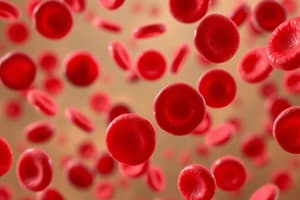Podcast
Questions and Answers
Why is heme iron absorbed more efficiently than non-heme iron?
Why is heme iron absorbed more efficiently than non-heme iron?
- It binds directly to transferrin for transport.
- It is directly absorbed into the bloodstream.
- It is stored directly in the bone marrow.
- It is derived from animal foods, which the body processes more easily. (correct)
Ferroportin is responsible for transporting iron into storage within cells.
Ferroportin is responsible for transporting iron into storage within cells.
False (B)
What is the primary role of hephaestin and ceruloplasmin in iron metabolism?
What is the primary role of hephaestin and ceruloplasmin in iron metabolism?
They oxidize iron to allow it to bind to transferrin.
A deficiency in the mineral ______ can lead to iron accumulation in tissues, potentially causing organ damage.
A deficiency in the mineral ______ can lead to iron accumulation in tissues, potentially causing organ damage.
Match each component of degraded erythrocytes with its eventual fate:
Match each component of degraded erythrocytes with its eventual fate:
Which of the following vitamins are critical for DNA synthesis, and therefore essential for the production of erythrocytes?
Which of the following vitamins are critical for DNA synthesis, and therefore essential for the production of erythrocytes?
Bilirubin is created directly from the iron portion of the heme molecule during erythrocyte degradation.
Bilirubin is created directly from the iron portion of the heme molecule during erythrocyte degradation.
What is the role of macrophages in the erythrocyte life cycle, and where are these cells primarily located?
What is the role of macrophages in the erythrocyte life cycle, and where are these cells primarily located?
The waste product _______ is created from biliverdin and binds to albumin for transport to the liver.
The waste product _______ is created from biliverdin and binds to albumin for transport to the liver.
What happens to the urobilinogen that is created from bilirubin in the large intestine?
What happens to the urobilinogen that is created from bilirubin in the large intestine?
Flashcards
Copper
Copper
A trace mineral; component of hephaestin and ceruloplasmin plasma proteins, which are needed for hemoglobin production.
Zinc
Zinc
A trace mineral; functions as a coenzyme that facilitates the synthesis of the heme portion of hemoglobin.
B Vitamins (Folate and B12)
B Vitamins (Folate and B12)
B vitamins that function as co-enzymes that facilitate DNA synthesis, and are critical for the synthesis of new erythrocytes.
Macrophage
Macrophage
Signup and view all the flashcards
Globin
Globin
Signup and view all the flashcards
Biliverdin
Biliverdin
Signup and view all the flashcards
Bilirubin
Bilirubin
Signup and view all the flashcards
Transferrin
Transferrin
Signup and view all the flashcards
Ferritin/Hemosiderin
Ferritin/Hemosiderin
Signup and view all the flashcards
Study Notes
Iron's Role in Erythrocyte Production
- Iron is a trace mineral present in each heme group of a hemoglobin molecule.
- The body absorbs less than 20% of consumed iron.
- Heme iron, found in animal foods, is absorbed more efficiently than non-heme iron from plants.
- Absorbed iron contributes to the body's total iron pool.
- Bone marrow, liver, and spleen store iron in ferritin and hemosiderin.
- Ferroportin transports iron across intestinal cell membranes and from storage into tissue fluid for blood transport.
- EPO stimulates erythrocyte production, which causes iron to be released from storage sites.
- Iron then binds to transferrin, and is carried to the red marrow where it can attach to erythrocyte precursors.
Copper's Role in Erythrocyte Production
- Copper is a trace mineral and a component of hephaestin and ceruloplasmin.
- Without copper, hemoglobin production would be inadequate.
- Hephaestin, located in intestinal villi, enables iron absorption by intestinal cells.
- Ceruloplasmin transports copper.
- Both hephaestin and ceruloplasmin enable the oxidation of iron from Fe2+ to Fe3+, so that it can bind to transferrin.
- Copper deficiency reduces iron transport for heme synthesis.
- Copper deficiency can lead to iron accumulation in tissues and eventual organ damage.
Zinc's Role in Erythrocyte Production
- Zinc is a trace mineral and a co-enzyme that facilitates the synthesis of the heme portion of hemoglobin.
B Vitamins' Role in Erythrocyte Production
- Folate and vitamin B12 are B vitamins that act as co-enzymes to facilitate DNA synthesis.
- Folate and vitamin B12 are critical for the synthesis of new cells, including erythrocytes.
Erythrocyte Life Cycle Overview
- Erythrocytes circulate for up to 120 days.
- Macrophages, myeloid phagocytic cells in the bone marrow, liver, and spleen, remove worn-out erythrocytes.
- Hemoglobin components from degraded erythrocytes are processed further.
Globin Breakdown
- Globin, the protein portion of hemoglobin, breaks down into amino acids.
- These amino acids is can be reused in the bone marrow to produce new erythrocytes.
- Hemoglobin that is not phagocytized breaks down in the circulation, releasing alpha and beta chains.
- The chains are then removed from circulation by the kidneys.
Iron Recycling
- Iron from the heme portion of hemoglobin is stored in the liver or spleen as ferritin or hemosiderin.
- The iron can also be carried by transferrin in the bloodstream to the red bone marrow.
- The iron is then recycled into new erythrocytes.
Non-Iron Heme Portion Breakdown
- The non-iron heme portion degrades into biliverdin, a green pigment, and then into bilirubin, a yellow pigment.
- Bilirubin binds to albumin and travels to the liver.
- The liver uses bilirubin to manufacture bile, which emulsifies dietary fats in the intestines.
- In the large intestine, bacteria convert bilirubin into urobilinogen and then into stercobilin.
- Stercobilin is then eliminated from the body in the feces.
- Broad-spectrum antibiotics can affect the bacteria involved in this process and may alter the color of feces.
- Kidneys also remove bilirubin and related byproducts like urobilins from circulation and secrete them into the urine.
Studying That Suits You
Use AI to generate personalized quizzes and flashcards to suit your learning preferences.




